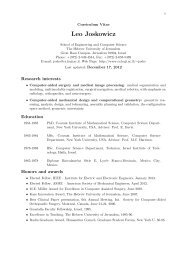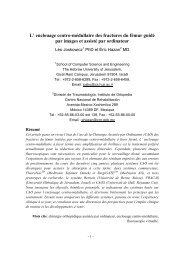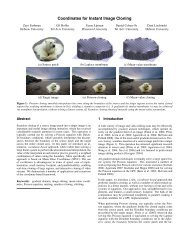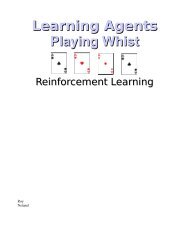TEL AVIV UNIVERSITY Gaddi Blumrosen
TEL AVIV UNIVERSITY Gaddi Blumrosen
TEL AVIV UNIVERSITY Gaddi Blumrosen
Create successful ePaper yourself
Turn your PDF publications into a flip-book with our unique Google optimized e-Paper software.
The error probability bound in Rayleigh fading model is:<br />
NT 1 <br />
Pe <br />
2<br />
j 11 j/ 4<br />
<br />
<br />
<br />
NT<br />
<br />
j <br />
<br />
j1<br />
<br />
2<br />
1/ 4<br />
Where r is the rank of A.<br />
A<br />
j<br />
(3.20)<br />
Since are the coding matrix eigenvalues, the first term in the multiplication in<br />
Nr<br />
NT<br />
<br />
(3.20), j , can be interrupted as coding gain (coding factor) and the second<br />
j1<br />
<br />
exponent of the second term, r m<br />
A , is the SNR factor of each sub-channel or spatial<br />
diversity gain.<br />
A design criteria for uncorrelated Rayleigh fading, account also for all cases, of slow<br />
fading with low values of rN R was obtained in [19]. Other criteria should be applied<br />
to other cases such as fast fading or large values of rN R<br />
The design criteria for uncorrelated Rayleigh fading consists of two stages:<br />
1. The Rank Criterion<br />
In order to achieve the maximum diversity, the matrix has to maximize the minimum<br />
rank over the set of all two distinct codewords.<br />
2. The Determinant Criterion<br />
Maximize the minimum determinant of the matrix A, along the pairs of distinct<br />
codewords with the minimum rank.<br />
If the channel coefficients are correlated, we face degradation in performance due to<br />
the decrease in system diversity order. With the same expressions and design<br />
criterions are used for the correlated case [19], there is the following penalty in coding<br />
gain and consequently to the over all gain, expressed in Decibels:<br />
L 10/( N N ) log10<br />
det( )<br />
(3.21)<br />
los<br />
h<br />
where E(<br />
H H)<br />
.<br />
Nr Nr<br />
<br />
R<br />
T<br />
<br />
3.3.3 Orthogonal Space-time codes (OSTBC)<br />
In this section we will examine the properties of a family of STC, OSTBC which are<br />
derived from the performance criterion in (3.20). When the transmitted data is<br />
encoded using a OSTBC, the encoded data is split into NT<br />
streams from each antenna<br />
which tend to be independent as much as and thus designed to achieve the maximum<br />
diversity order. OSTBC enable simple maximum-likelihood decoding algorithm,<br />
which is based only on linear processing at the receiver rather than joint detection.<br />
A simple transmit OSTBC for two antennas was first derived in [20].<br />
The classical mathematical framework of orthogonal designs is applied to construct<br />
space–time block codes [21], [22].<br />
In orthogonal code matrix,<br />
I N i j<br />
H<br />
T<br />
XX j <br />
0 N i j<br />
T<br />
(3.22)<br />
Where X ,<br />
, are the i‟th and j‟th columns respectively.<br />
i X j<br />
rm<br />
A








